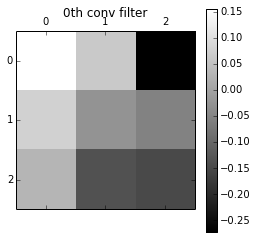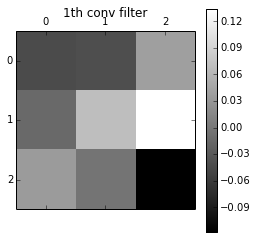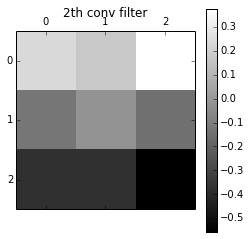SIMPLE CONVOLUTIONAL NEURAL NETWORK
import numpy as np
import tensorflow as tf
import matplotlib.pyplot as plt
from tensorflow.examples.tutorials.mnist import input_data
%matplotlib inline
print ("PACKAGES LOADED")
PACKAGES LOADED
LOAD MNIST
mnist = input_data.read_data_sets('data/', one_hot=True)
trainimg = mnist.train.images
trainlabel = mnist.train.labels
testimg = mnist.test.images
testlabel = mnist.test.labels
print ("MNIST ready")
Extracting data/train-images-idx3-ubyte.gz
Extracting data/train-labels-idx1-ubyte.gz
Extracting data/t10k-images-idx3-ubyte.gz
Extracting data/t10k-labels-idx1-ubyte.gz
MNIST ready
SELECT DEVICE TO BE USED
device_type = "/gpu:1"
DEFINE CNN
with tf.device(device_type):
n_input = 784
n_output = 10
weights = {
'wc1': tf.Variable(tf.random_normal([3, 3, 1, 64], stddev=0.1)),
'wd1': tf.Variable(tf.random_normal([14*14*64, n_output], stddev=0.1))
}
biases = {
'bc1': tf.Variable(tf.random_normal([64], stddev=0.1)),
'bd1': tf.Variable(tf.random_normal([n_output], stddev=0.1))
}
def conv_simple(_input, _w, _b):
_input_r = tf.reshape(_input, shape=[-1, 28, 28, 1])
_conv1 = tf.nn.conv2d(_input_r, _w['wc1'], strides=[1, 1, 1, 1], padding='SAME')
_conv2 = tf.nn.bias_add(_conv1, _b['bc1'])
_conv3 = tf.nn.relu(_conv2)
_pool = tf.nn.max_pool(_conv3, ksize=[1, 2, 2, 1], strides=[1, 2, 2, 1], padding='SAME')
_dense = tf.reshape(_pool, [-1, _w['wd1'].get_shape().as_list()[0]])
_out = tf.add(tf.matmul(_dense, _w['wd1']), _b['bd1'])
out = {
'input_r': _input_r, 'conv1': _conv1, 'conv2': _conv2, 'conv3': _conv3
, 'pool': _pool, 'dense': _dense, 'out': _out
}
return out
print ("CNN ready")
CNN ready
DEFINE COMPUTATIONAL GRAPH
x = tf.placeholder(tf.float32, [None, n_input])
y = tf.placeholder(tf.float32, [None, n_output])
learning_rate = 0.001
training_epochs = 10
batch_size = 100
display_step = 1
with tf.device(device_type):
_pred = conv_simple(x, weights, biases)['out']
cost = tf.reduce_mean(tf.nn.softmax_cross_entropy_with_logits(_pred, y))
optm = tf.train.AdamOptimizer(learning_rate=learning_rate).minimize(cost)
_corr = tf.equal(tf.argmax(_pred,1), tf.argmax(y,1))
accr = tf.reduce_mean(tf.cast(_corr, tf.float32))
init = tf.initialize_all_variables()
save_step = 1;
savedir = "nets/"
saver = tf.train.Saver(max_to_keep=3)
print ("Network Ready to Go!")
Network Ready to Go!
OPTIMIZE
DO TRAIN OR NOT
do_train = 1
sess = tf.Session(config=tf.ConfigProto(allow_soft_placement=True))
sess.run(init)
if do_train == 1:
for epoch in range(training_epochs):
avg_cost = 0.
total_batch = int(mnist.train.num_examples/batch_size)
for i in range(total_batch):
batch_xs, batch_ys = mnist.train.next_batch(batch_size)
sess.run(optm, feed_dict={x: batch_xs, y: batch_ys})
avg_cost += sess.run(cost, feed_dict={x: batch_xs, y: batch_ys})/total_batch
if epoch % display_step == 0:
print ("Epoch: %03d/%03d cost: %.9f" % (epoch, training_epochs, avg_cost))
train_acc = sess.run(accr, feed_dict={x: batch_xs, y: batch_ys})
print (" Training accuracy: %.3f" % (train_acc))
test_acc = sess.run(accr, feed_dict={x: testimg, y: testlabel})
print (" Test accuracy: %.3f" % (test_acc))
if epoch % save_step == 0:
saver.save(sess, "nets/cnn_mnist_simple.ckpt-" + str(epoch))
print ("Optimization Finished.")
Epoch: 000/010 cost: 0.326192696
Training accuracy: 0.980
Test accuracy: 0.959
Epoch: 001/010 cost: 0.105607550
Training accuracy: 0.960
Test accuracy: 0.975
Epoch: 002/010 cost: 0.072013733
Training accuracy: 0.960
Test accuracy: 0.979
Epoch: 003/010 cost: 0.056868095
Training accuracy: 0.990
Test accuracy: 0.980
Epoch: 004/010 cost: 0.047069814
Training accuracy: 0.990
Test accuracy: 0.983
Epoch: 005/010 cost: 0.040124569
Training accuracy: 0.980
Test accuracy: 0.983
Epoch: 006/010 cost: 0.035343169
Training accuracy: 0.990
Test accuracy: 0.983
Epoch: 007/010 cost: 0.030736405
Training accuracy: 1.000
Test accuracy: 0.984
Epoch: 008/010 cost: 0.026192359
Training accuracy: 0.990
Test accuracy: 0.983
Epoch: 009/010 cost: 0.024165640
Training accuracy: 1.000
Test accuracy: 0.983
Optimization Finished.
RESTORE
if do_train == 0:
epoch = training_epochs-1
saver.restore(sess, "nets/cnn_mnist_simple.ckpt-" + str(epoch))
print ("NETWORK RESTORED")
LET'S SEE HOW CNN WORKS
with tf.device(device_type):
conv_out = conv_simple(x, weights, biases)
input_r = sess.run(conv_out['input_r'], feed_dict={x: trainimg[0:1, :]})
conv1 = sess.run(conv_out['conv1'], feed_dict={x: trainimg[0:1, :]})
conv2 = sess.run(conv_out['conv2'], feed_dict={x: trainimg[0:1, :]})
conv3 = sess.run(conv_out['conv3'], feed_dict={x: trainimg[0:1, :]})
pool = sess.run(conv_out['pool'], feed_dict={x: trainimg[0:1, :]})
dense = sess.run(conv_out['dense'], feed_dict={x: trainimg[0:1, :]})
out = sess.run(conv_out['out'], feed_dict={x: trainimg[0:1, :]})
print ("Size of 'input_r' is %s" % (input_r.shape,))
label = np.argmax(trainlabel[0, :])
print ("Label is %d" % (label))
plt.matshow(input_r[0, :, :, 0], cmap=plt.get_cmap('gray'))
plt.title("Label of this image is " + str(label) + "")
plt.colorbar()
plt.show()
Size of 'input_r' is (1, 28, 28, 1)
Label is 7
/usr/lib/pymodules/python2.7/matplotlib/collections.py:548: FutureWarning: elementwise comparison failed; returning scalar instead, but in the future will perform elementwise comparison
if self._edgecolors == 'face':

Conv1 (convolution)
print ("Size of 'conv1' is %s" % (conv1.shape,))
for i in range(3):
plt.matshow(conv1[0, :, :, i], cmap=plt.get_cmap('gray'))
plt.title(str(i) + "th conv1")
plt.colorbar()
plt.show()
Size of 'conv1' is (1, 28, 28, 64)
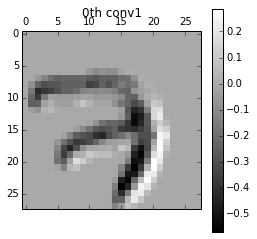
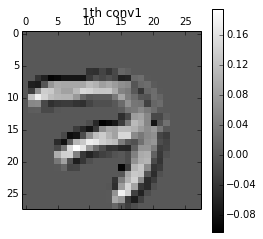
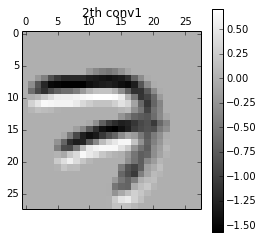
Conv2 (+bias)
print ("Size of 'conv2' is %s" % (conv2.shape,))
for i in range(3):
plt.matshow(conv2[0, :, :, i], cmap=plt.get_cmap('gray'))
plt.title(str(i) + "th conv2")
plt.colorbar()
plt.show()
Size of 'conv2' is (1, 28, 28, 64)
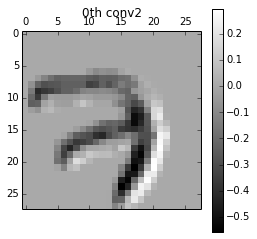
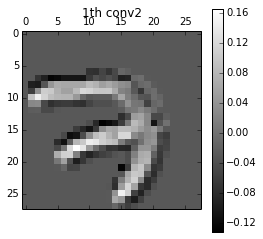
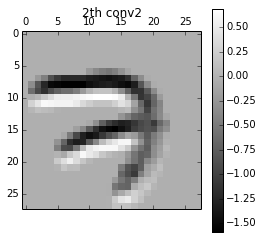
Conv3 (ReLU)
print ("Size of 'conv3' is %s" % (conv3.shape,))
for i in range(3):
plt.matshow(conv3[0, :, :, i], cmap=plt.get_cmap('gray'))
plt.title(str(i) + "th conv3")
plt.colorbar()
plt.show()
Size of 'conv3' is (1, 28, 28, 64)

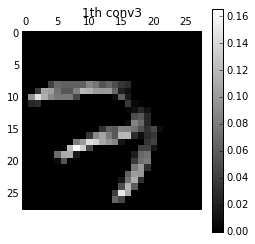

Pool (max_pool)
print ("Size of 'pool' is %s" % (pool.shape,))
for i in range(3):
plt.matshow(pool[0, :, :, i], cmap=plt.get_cmap('gray'))
plt.title(str(i) + "th pool")
plt.colorbar()
plt.show()
Size of 'pool' is (1, 14, 14, 64)

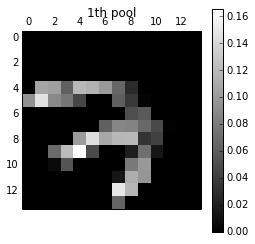

Dense
print ("Size of 'dense' is %s" % (dense.shape,))
print ("Size of 'out' is %s" % (out.shape,))
Size of 'dense' is (1, 12544)
Size of 'out' is (1, 10)
Convolution filters
wc1 = sess.run(weights['wc1'])
print ("Size of 'wc1' is %s" % (wc1.shape,))
for i in range(3):
plt.matshow(wc1[:, :, 0, i], cmap=plt.get_cmap('gray'))
plt.title(str(i) + "th conv filter")
plt.colorbar()
plt.show()
Size of 'wc1' is (3, 3, 1, 64)
